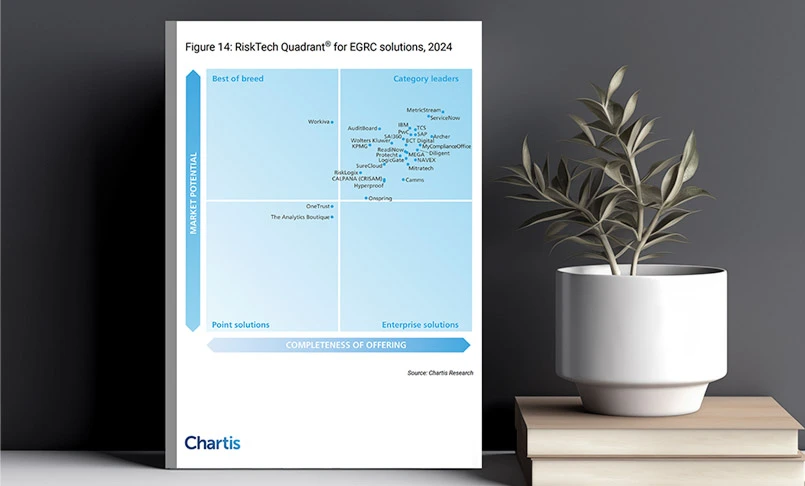Top 5 Risk and Compliance Resolutions for GRC Leaders in 2025
- Risk Management
- 23 January 25

Introduction
Do you believe in New Year’s resolutions?
In my personal life, I usually make one or two big changes every January—and they’ve mostly (!) held. A new year is a great time for fresh starts, bold aspirations, and a renewed focus on change, growth, and innovation.
That holds true for companies and industries – especially in governance, risk, and compliance (GRC). Across industries, organizations are gearing up to tackle challenges head-on, enhance their capabilities, and embrace the transformative potential of cutting-edge technologies. Organizations are bracing themselves for the unknown unknowns stemming from escalating geo-political conflicts in various parts of the world, a volatile economic outlook, intensifying cyber risks, severe supply chain disruptions, an array of new regulations, and more
According to the World Economic Forum’s 2025 Global Risks Report, “the overall view of global risks is much the same as last year if more negatively weighted.” Along with spotlighting extreme weather events, increasing misinformation, and cyber attacks, the report also highlighted ‘the adverse outcomes of AI technologies’ as a risk to be expected in the long term.
So, while leadership and top management review the past year and chalk out business goals and strategies for the year ahead, GRC leaders should take this opportunity to rethink their approach and implement changes in processes, tools, and technologies that will boost their organization’s resilience.
Against this backdrop, here are 5 key risk and compliance resolutions for organizations to help successfully navigate 2025. What are yours? Let us know in the comments!
1. See Risk as an Opportunity – A Must for Thriving in 2024!
Risk is an inherent part of business. Instead of viewing risk as detrimental to the organization’s growth and financial posture, GRC leaders should look to turn risks into opportunities. The willingness to take risks can help organizations gain a competitive edge and drive greater profitability and business value. However, there’s a catch—not all risks translate into strategic advantage. So, how can organizations decide whether to accept, reject, avoid, or mitigate a risk?
This is where the risk management program comes into play. An effective risk management program can enable decision-makers to make well-informed business decisions by providing a streamlined process for evaluating opportunities. It equips the top management and leadership with actionable insights, improved risk visibility and foresight, and greater transparency that helps them better manage projects based on risk impact and probability in relation to potential return.
Explore the top risk and compliance trends for 2025: GRC Forecast for 2025: 7 Must-Know Trends
2. Step Up Cyber Risk Management – Automation is Key!
In just the second quarter of 2024, cyberattacks worldwide shot up by 30%, reaching 1,636 attacks per organization per week, according to Check Point Research.
To protect their IT and cyber infrastructure from frequent and increasingly sophisticated cyber attacks, organizations need to level up their cyber risk management approach. Relying on periodic reviews and assessments of cyber risks and controls is no longer enough. Organizations need an automated, autonomous, and continuous approach that enables them to proactively identify and address any risks, threats, vulnerabilities, control weaknesses/gaps, and issues before they snowball into something significant.
Organizations today can also harness the power of artificial intelligence (AI) and other advanced technologies to improve risk management processes and enhance efficiency. AI can significantly accelerate the decision-making process by quickly providing insights into risk trends and patterns as well as identifying areas of improvement – such as the number of duplicate or redundant controls, patterns of over and under-testing of controls, optimum control testing frequency, similar issues, and more.
Discover the upcoming cyber shifts in 2025: 10 Cyber GRC Trends to Watch in 2025
3. Level Up the Compliance Game – Time to Stop Playing Catch-Up!
Regulatory compliance is becoming an increasingly challenging and demanding business function for organizations worldwide.
The year 2024 witnessed significant regulatory advancements, with a strong emphasis on resilience, AI, cyber risk and security, third-party risks, and ESG. This momentum is expected to carry forward into 2025 as regulations continue to evolve in critical areas such as Trusted AI and Systems, Cybersecurity and Information Protection, Financial and Operational Resilience, Financial Crime, Markets and Competition, and Risk Governance and Controls. Alongside new regulations like Digital Operational Resilience Act (DORA), NIS2, and the EU AI Act, organizations must also prepare for emerging regulations such as the Cyber Incident Reporting for Critical Infrastructure Act (CIRCIA), various US state data privacy laws, the EU Cyber Solidarity Act, the updated EU Product Liability Directive, the Corporate Sustainability Reporting Directive (CSRD), and the EU Deforestation Regulation.
Given the ever-increasing regulatory requirements, compliance teams inevitably fall behind. They spend most of their time tracking relevant regulations, understanding their impact on organizational processes, functions, risks, policies, and controls, implementing the required changes, and so on. Technology can make a huge difference in how these various compliance management tasks are performed.
Automated compliance is the future! Today, there are tools that leverage AI to scan the regulatory horizon for identifying relevant regulations and regulatory updates, quickly show the impacted processes, functions, risks, policies, and controls using a centralized platform, run autonomous control tests to ensure adherence to relevant regulations, generate reports that demonstrate compliance posture, and more. The technology-driven, automated approach can streamline compliance management activities and help strengthen compliance resilience.
Check out our eBook: Compliance Excellence: Top Strategies To Navigate The Regulatory Landscape
4. Implement AI for GRC and GRC for AI – Act Now or Lag Behind!
With its ability to provide actionable insights, save time and costs, and create bandwidth for risk, compliance, audit, security, and sustainability teams, AI is already being regarded as a game-changer for GRC. While AI will not completely replace the need for human involvement, it can eliminate the possibility of human error, thereby improving the accuracy of GRC processes and decision-making and ensuring there are no blind spots.
At the same time, it is essential to ensure responsible AI innovation. As organizations explore more use cases and integrate AI capabilities into their processes, they also have the duty to follow the highest standards to ensure its ethical and responsible use and implement measures to identify, manage, and manage AI risks. Think GRC for AI, if you will.
Regulators and standard-setting bodies have already taken steps toward this goal. The landmark EU AI Act will regulate AI in the EU by 2026. However, its reach will extend beyond the EU and affect more than just tech companies. In the US, the White House Office of Science and Technology Policy has formulated the Blueprint for an AI Bill of Rights. Other countries like the UK, Singapore, Australia, and India have also issued their own guidelines or principles around responsible AI.
To ensure responsible AI adoption, organizations should establish clear governance frameworks, conduct comprehensive risk assessments, promote transparency, monitor AI systems continuously, appoint accountable leadership, form cross-functional ethics committees, and educate employees on AI risks and compliance. These measures help align AI initiatives with ethical standards, legal requirements, and industry best practices.
AI-focused innovation has been central to MetricStream’s product and platform releases over the years. Our AI capabilities span diverse GRC use cases – from issue identification and classification, action plan recommendations, and scanning of SOC2 and SOC3 reports submitted to organizations by third parties, to , AiSPIRE, an AI-based knowledge-centric tool that provides intelligent insights to improve an organization’s control environment.
Read our latest eBook on the topic: AI: The Next Frontier in GRC
5. Strengthen Resilience – Focus on More than Business Continuity!
In 2024, cyber and operational resilience emerged as critical focal points for regulators and organizations, driven by an increasingly severe risk landscape. Disruptions caused by extreme climate events, geopolitical tensions, and IT outages underscored the urgency of building resilience to ensure quick recovery. Key regulations like the EU’s DORA for cyber resilience and the UK’s operational resilience policies from the Bank of England (BoE), Financial Conduct Authority (FCA), and Prudential Regulation Authority (PRA), highlight this growing emphasis. In the US, the Federal Reserve Board (FRB), Office of the Comptroller of the Currency (OCC), and Federal Deposit Insurance Corporation (FDIC) released a joint paper on operational resilience, while the Securities and Exchange Commission (SEC) mandated increased transparency around cybersecurity incidents. Globally, similar frameworks, such as Singapore’s guidelines, Hong Kong’s policy manual, and Canada’s Guideline E-21, reflect a universal recognition of the need for resilience in the face of operational and cyber threats.
Building robust resilience requires a well-structured operational risk management (ORM) program, as noted by the Basel Committee on Banking Supervision, which links operational resilience to effective ORM. Organizations must align their operational risk appetites and impact tolerances with resilience strategies, utilizing scenario planning, simulations, and proactive incident response testing. At the same time, cyber resilience will remain a top priority due to rising cyber threats and regulations like the EU’s Cyber Resilience Act (CRA). By fostering a culture of cybersecurity awareness and maintaining continuous risk monitoring, organizations can better protect their operations, minimize disruptions, and preserve stakeholder trust.
Explore more in the article: Operational Resilience: The Outcome of an Effective ORM Program
Looking Ahead
I’d like to close with two of my mother’s favorite quotes: “The perfect is the enemy of the good” and “A stitch in time saves nine.”
The first one she said so often I thought it was hers, but it’s a quote from 18th-century French philosopher and writer Voltaire. I use it all the time – don’t wait for perfection to start, and don’t let lack of perfection slow you down. The time to start improving your GRC journey is now.
The second quote also speaks to starting now and getting ahead: be proactive, not reactive. And I think it really was hers. Thanks, Mom!
Need help on your GRC Journey? Request a personalized demo today.
And… Happy New Year!








